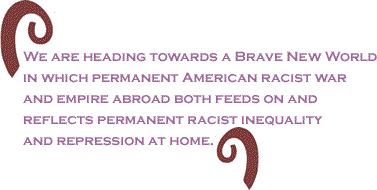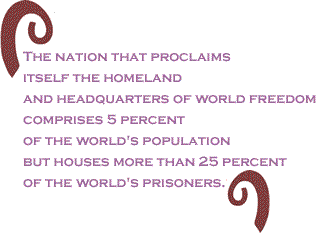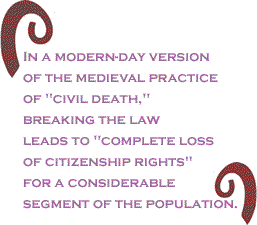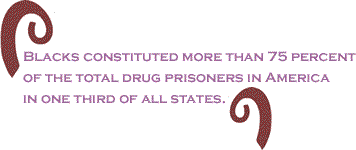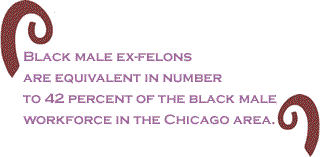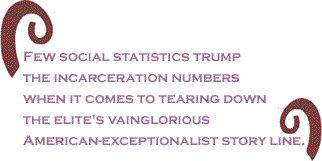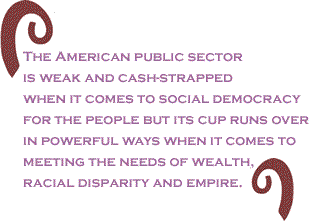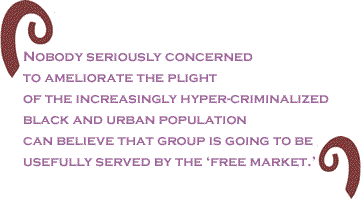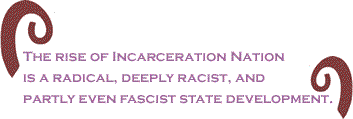
|
|||||||||||||||||||||
|
The following article was first published on Znet. Let me start by quoting my favorite historical personality from Indiana – the great democratic Socialist Eugene Debs, from Terre Haute. "While there is a lower class," Debs once said, "I am of it. While there is a criminal element," he added, "I am of it; while there is a soul in prison, I am not free." Prison Nation: "Not Unless This Country Plunges Into Fascism" Debs would feel most un-free in contemporary America, where 2 million adults spend their days behind bars in the nation that possesses the world's highest incarceration rate. In the second year of the new millennium, 40 of every 100,000 people in Italy were imprisoned. The incarceration rate in Sweden was 60 per 100,000. France: 90 per 100,000. England: 125. South Africa: 400 per 100,000. Russia, with the second highest rate in the world: 675. The United States led the world with 690 per 100,000. Incredibly enough, the nation that proclaims itself the homeland and headquarters of world freedom comprises 5 percent of the world's population but houses more than 25 percent of the world's prisoners. "No other Western democratic country has ever imprisoned this proportion of its population," says Norval Morris, a professor emeritus at University of Chicago Law School. Indiana and Illinois are playing major roles in this dark drama, contributing 43,000 (Illinois) and 22,000 (Indiana) state prisoners, respectively to the inmate total in Prison Nation. With federal, local and county prisoners included, the numbers would be considerably higher. America's incarceration numbers are off the charts relative to the rest of the world but they are also off the charts relative to our own history. In the last two-and-a-half decades, America's prison population has undergone "literally incredible" expansion, rising from less than 300,000 in 1970 to the current shocking number. There were less than 7500 state prison inmates in the entire state of Illinois in 1970. Thirty one years later, I found 7500 Illinois prisoners coming from just six of Chicago's sixty-six zip codes, including five on the city's west side and one on the south side. During the same period the number of prisons in my state rose from 7 to 27.
Reviewing these numbers I am struck by the depths of an amazing domestic development that has taken place quietly, behind the scene, during my lifetime, captured quite well by Angela Davis. "When I first became involved in anti-prison activities during the late 1960s," writes Davis, "I was astounded to learn that there were then close to two hundred thousand people in prison. Had anyone told me that in three decades ten times as many people would be locked away in cages, I would have been absolutely incredulous. I imagine that I would have responded something like this: 'As racist and undemocratic as this country may be [remember, during that period, the demands of the Civil Rights Movement had not yet been consolidated], I do not believe that the U.S. government will be able to lock up so many people without producing powerful resistance. No, this will never happen, not unless this country plunges into fascism." (Angela Y. Davis, Are Prisons Obsolete? Seven Stories Press, 2003, p.11) The US incarceration rate began its dramatic upward acceleration in the mid-1970s, after nearly 50 years during which it hovered around 100 per 100,000. Incarceration is now so extensive that several large states currently spend as much or more money to incarcerate adults than they do to provide their citizens with college and graduate educations. States now spend 60 cents on prisons for every dollar they spend on higher education, up from 28 cents in 1980. Ex-Offender Nation: the Mark of a Criminal Record
Less commonly noted, America's mass imprisonment and related felony marking boom has also generated a massive army of "ex-offenders," whose liberty on the "outside" is strictly qualified by the lifelong mark of a criminal record. More than 600,000 individuals are released from state and federal prisons each year, feeding a swelling army of ex-offenders, saddled with what The Economist last year called "The Stigma That Never Fades." According to the best recent estimates, roughly 13 million Americans – fully 7 percent of the adult population and 12 percent of the adult male population – possess felony records. Thanks to numerous barriers to ex-offender "reintegration" (a phrase that tends to too-easily assume that former prisoners were meaningfully integrated into American "opportunity structures" prior to arrest and imprisonment), many released inmates claim that their "real sentence" began upon release. This claim often contains a measure of exaggeration, no doubt: "modern" US prisons are violent and totalitarian structures, monuments of intentionally planned mass misery, unmitigated by meaningful investment in rehabilitation and treatment. Still, former prisoners face remarkable obstacles. One of the key barriers comes in the realm of employment. According to the best recent estimates, incarceration carries a significant 10 to 20 percent "wage penalty." "Prison time," Northwestern sociologist Devah Pager notes, "serves to channel individuals away from skilled occupations and into job sectors which are characterized by low wages, limited job stability, and fewer opportunities for advancement." Based on interviews with 3000 employers by the Multi-City Study of Urban Inequality, researchers report, more than 60 percent of employers would not knowingly hire an ex-offender. Possession of a felony record is the single worst barrier to employer acceptance. This is no small societal problem when 13 million possess such records in a capitalist society, where most adults must purchase commodified life necessities through an exchange medium that is obtained primarily by renting out their labor power on a sustained basis. Employer and other forms of societal bias against "ex-offenders" help explain why roughly two-thirds of released prisoners are rearrested within three years. A considerable and growing segment of the population has become part of a permanently stigmatized "underclass" that recycles in and out of jails and prisons. It forms an everlasting "criminal element" that is pushed yet further into the lower class and functions as the key raw material for a bloated, super-expensive hyper-carceral criminal justice state. "Civil Death" Along with socioeconomic disenfranchisement comes literal political disenfranchisement. "Currently," note the leading academic authorities on felon and ex-felon-voting rights (Jeff Manza and Christopher Uggen), "48 states disenfranchise incarcerated felons, 37 states disenfranchise felony probationers or parolees (or both), and 14 states additionally disenfranchise some or all ex-felons who have completed their sentences." No other democratic nation denies the vote to a remotely comparable share of its offender and ex-offender population. One of the worst 14 states is of course Florida, where felony disenfranchisement, supplemented by the scandalous and illegal denial of voting rights to many persons who were merely suspected of possessing felony records and others whose out-of-state felony records (see the chilling first chapter, "Jim Crow in Cyberspace," in Greg Palast's best-selling The Best Democracy Money Can Buy) provided the spectacular world-systemic transgressor George W. Bush with a key part of his "winning" margin in the pitiful presidential selection of 2000.
The roughly 4.4 million Americans who are disenfranchised due to a past or current felony conviction "are expected," note the experts, "to respect the law (and indeed, are often subject to significantly harsher penalties and face a higher level of scrutiny, than non-felons). They are expected to pay taxes to the government, and to be governed by elected officials. Yet they have no formal right to participate in the selection of those officials or the public policies that allocate government expenditures," including the tens of billions of dollars that American government's spend on mass incarceration. Even in the horribly diluted and qualified mechanism of democracy known as the American voting process, much of the "criminal element" is banned from having anything to say about the policies that have marked them for life. In a modern-day version of the medieval practice of "civil death," breaking the law leads to "complete loss of citizenship rights" for a considerable segment of the population. At the same time, it is worth noting that prisoners count towards the population count and therefore to the political representation (under political districting rules) and related state and federal funding allotments granted not to their home communities (disproportionately urban) but to (disproportionately rural) regions and communities that host prisons. An investigation by The Chicago Reporter - an excellent local public affairs magazine - finds that mass incarceration's interaction with the geography of prison construction, political districting rules and federal budgetary procedures cost Chicago's Cook County nearly $88 million in federal benefits between 2000 and 2010 (see Molly Dugan, "Census Dollars Bring bounty to Prison Towns"). Corrections, Indeed: The Color of Prison and Ex-Offender Nation Let's be clear, however, about who exactly is most prone to socioeconomic and political disenfranchisement through incarceration and related felony-marking. Beyond its sheer magnitude, the most striking aspect of America's prison and broader criminal supervision boom is its heavily racialized nature. As the penal population has risen, it has become significantly less Caucasian: non-Hispanic whites accounted for 42% of state prison inmates in 1979 but less than a third by the end of the 20th century. One group is most especially targeted: Blacks are 12.3 percent of US population, but they comprise roughly half of the roughly 2 million Americans currently behind bars. Between 1980 and 2000, the number of black men in jail or prison grew fivefold (500 percent), to the point where, as the Justice Policy Institute (2002) recently reported, there were more black men behind bars than enrolled in colleges or universities in the US. On any given day, Chaiken reported, 30 percent of African-American males ages 20 to 29 are under correctional supervision – either in jail or prison or on probation or parole.
The incarceration rate for African-Americans is 1,815 per 100,000 compared to 609 per 100, 000 for Latino-Americans, 99 per 100,000 for Asian-Americans, and 235 per 100, 000 for American whites. For black adult males the incarceration rate is a remarkable 4, 484 per 100,000, compared 1, 668 per 100,000 for Hispanic males and 1,318 per 100,000 for white males. Roughly one in ten of the world's prisoners is an African-American male. In mid-year 1999, 11 percent of Black US males in their 20s and early 30s were in prison and 33 percent of Black male high school dropouts were in prison or in jail. Especially chilling is a statistical model used by the Bureau of Justice Statistics at the turn of the 21st century to determine the lifetime chances of incarceration for individuals in different racial and ethnic groups. Based on current rates, it predicts that a young Black man age 16 in 1996 faced a 29 percent chance of spending time in prison during his life. The corresponding statistic for white men in the same age group was 4 percent. Consistent with these findings, nothing is more likely to predict high incarceration totals and rates at the state level than the possession of a disproportionately large black population. Also worth noting, race is the single largest factor determining which states deny voting rights to felons and ex-felons. The higher the black composition of a state's prisoner population, the more likely that state is to disenfranchise its officially marked "criminal element." A recent New Left Review essay by left sociologist Loic Wacquant is titled "From Slavery to Mass Incarceration." The experience of incarceration is so ubiquitous and commonplace in the African-American experience today that Wacquant can make a compelling case for designating mass imprisonment as a full-blown historical stage in the evolution of structural racism in the United States. Meanwhile, criminologists Dina Rose and Todd Clear found Black neighborhoods in Tallahassee where every resident could identify at least one friend or relative who has been incarcerated. In predominantly Black urban communities across the country, incarceration is so widespread and commonplace that it has become what Chaiken calls "almost a normative life experience." The phenomenon of heavily disproportionate Black mass incarceration is fraught with a savage historical irony. At the very moment that American public discourse in racial matters has become officially inclusive – even David Duke now has to deny that he is anti-Black – the US is flooding its expanding number of cell blocks with an ever-rising tide of Black people monitored by predominantly white overseers. There is a widespread false belief among whites – ironically reinforced by the demise of open public racial prejudice – that African-Americans enjoy equal and color-blind opportunity. "As white America sees it," write Barbara Diggs-Brown and Leonard Steinhorn in their sobering By the Color of Their Skin: the Illusion of Integration and the Reality of Race (2000), "every effort has been made to welcome Blacks into the American mainstream, and now they're on their own… 'We got the message, we made the corrections [white Americans claim, P.S.] – Get on with it.'" Corrections, indeed: as the racially skewed demographics of the American "correctional" system suggest, the US in the age of mass incarceration is giving a darkly colored twist to the noble Christian notion that we are "our brother's [today 'our brothers'] keeper." A Policy-Driven Reality
At first blush, an outside observer from another country or planet might observe America's prison numbers and conclude that the United States experienced a significant upsurge in violent crimes, disproportionately committed by African-Americans, during recent decades. This would be a reasonable inference from the extreme measure (by both historical American and contemporary global standards) of mass and racially disparate incarceration over the last 25-30 years. Contrary to the "law and order" rhetoric cultivated by many politicians and policymakers, however, there has been no clear or consistent pattern of rising criminality, including violent criminality, that might explain the upward trend of America's prison numbers. "Since 1980," journalist Vince Beiser notes, "the national crime rate has meandered down, then up, then down again, but the incarceration rate has marched relentlessly upward every single year." During the 1990s, indeed, the US incarceration rates rose dramatically in spite of crime rates that fell, thanks largely to fairly robust economic growth during the "Clinton boom." "Crime is dropping," noted the well-regarded public affairs journal Illinois Issues, "but the prison population isn't." The black crime rates have been consistently higher than the white crime rate, consistent with blacks' lower socioeconomic status and related higher stress levels and weaker social and familial structures, but there has been no massive upsurge of black criminality that could even remotely explain the skyrocketing black incarceration rate. The central factor is that imprisonment in the US has "changed," in Pager's words, "from a punishment reserved for only the most heinous offenders to one extended to a much greater range of crimes and much larger segment of the population [emphasis added]. Recent trends in crime policy have led to the imposition of harsher and longer sentences for a wider range of offenses, thus casting an ever widening net of penal intervention." It is largely for this reason that the majority of Americans entering the inherently violent space of America's "prison nation," where as many as 7 percent of inmates are raped, now do so for nonviolent crimes. Between 1980 and 1997, the Justice Policy Institute (JPI) reports, "the number of violent offenders committed to state prison nearly doubled (up 82 percent)," but "the number of nonviolent offenders tripled (up 207 percent)." People who committed nonviolent crimes accounted for more than three fourths of the nation's massive increase in prisoners between 1978 and 1996. The Justice Policy Institute estimates that there are currently more than 1.2 million nonviolent criminals behind bars in the US.
These trends have impacted black communities with special harshness. While blacks make up just 15 percent of illicit drug users, they account for 37 percent of those arrested for drug offenses. They comprise 42 percent of those held in federal prison for drug charges and 62 percent of those in state prisons. Not surprisingly, white drug offenders are much less likely than their counterparts to serve time in prison. Blacks constituted more than 75 percent of the total drug prisoners in America in one third of all states according to a report issued in 2000 by the prestigious human rights organization Human Rights Watch. In my own state, Illinois, Human Rights Watch reported that "blacks constituted an astonishing 90 percent of all drug offenders admitted to prison in Illinois" in 1996. By 2000, the percentage had barely fallen to 89 percent, making Illinois number two in the nation in terms of this key disparity. Chicago Story Reflecting these dark realities, there is now a growing and increasingly respectable body of academic and policy literature on "racially disparate mass incarceration" – liberal academic and foundation terminology for the racist prison state – and related issues of mass black criminalization and "prisoner reentry." The literature bears dramatic titles like The Race to Incarcerate, Incarceration Nation, Lockdown America, Prison Nation, Cell Blocks Over Classrooms, Travels in a Prison Nation, Color Bind, and the like. My own study released last year is part of this literature. Titled The Vicious Circle: Race, Prison, Jobs and Community in Chicago, Illinois and the Nation, it's full of shocking details on how and why the penal system has become a central part of the institutional framework that produces racial and related socioeconomic inequality in the United States. Among the worst revelations:
There is, I noted, a significant racial disparity in mass incarceration's labor market and related economic development consequences in Illinois as throughout the country. The prison construction boom – fed by the rising "market" of black offenders – is a significant source of jobs and associated local economic multipliers for prison-hosting "downstate" Illinois communities. Because of its racially dichotomous economic and related political and budgetary impact in Illinois, I argued in The Vicious Circle for understanding mass incarceration as a form of Reverse Racial Reparations - a form of radical state intervention that transfers wealth, census count, earnings, government dollars, voting power and even campaign finance influence away from the black and into the white community. The analogy with slavery (including the infamous "three-fifths" compromise that permitted slave states to count black chattel towards their Congressional representation) is hard to miss, though black prisoners function much more as raw material than as labor under the modern mass incarceration system. The Racist Prison State vs. National Mythology My study resonated well in Chicago's black community and among intellectuals and activists working to rollback American incarceration. It failed, however, to achieve remotely comparable recognition in the mainstream media, even at the local level. This lukewarm media response is fairly typical, I think, for those of us who are writing about and against the racist prison state. There's an epic disconnect between its significance (well understood especially in the black community) and the mainstream attention it receives, especially when you recall that George W. Bush seized power – with historic consequences – thanks to the disenfranchisement of tens of thousands black ex-felons (real and supposed) in Florida. "Freedom's Beacon"
The reasons for this disconnect are complex but part of the problem relates to the filtering power of dominant ideology, whose core elements are shared across the American political class, including both policymakers and owners and managers of the nations' media corporations. The full story of policy-driven racist mass imprisonment and related rampant black felony marking is richly anomalous for related core and overlapping American myths that dominant media has no interest in challenging, particularly in the post-9/11 period of intensified nationalism and related domestic mobilization for permanent imperialist war. One such myth holds that the United States is the natural homeland, epitome and headquarters of freedom, "the beacon to the world of the way life should be" – to quote Texas Senator Kay Bailey Hutchinson justifying her support for the White House's planned invasion of Iraq in the fall of 2002. Hutchinson's phrase epitomizes the widespread belief among the political class that America is the embodiment of human existence at its best – a God- and/or History-ordained City on a Hill, one that "stands taller and sees farther" than the rest of the world, as Madeline Albright put it years ago. This belief certainly informed a statement made by James F. Dobbins, Director of the Rand Corporation's Center for International Security and Defense Policy and a former special White House envoy during US interventions in Somalia, Haiti, Bosnia, Kosovo, and Afghanistan. "The partisan debate" within the US, "is over," Dobbins proclaimed just before the US invaded Iraq. "Administrations of both parties are clearly prepared," Dobbins noted, "to use American military forces to reform rogue states and repair broken societies." To counter this toxic national-imperial narcissism and show that the United States is itself a "broken society," activists can pick from an empirical embarrassment of riches relating to inequality, poverty, gun-deaths, suicides, the uninsured and so on. But few social statistics trump the incarceration numbers when it comes to tearing down the elite's vainglorious American-exceptionalist story line, particularly the part of the dominant trope that identifies the US with "freedom." Even if media authorities wanted to, it would be difficult for them to tell the truth on such a graphically counter-doctrinal horror story at the same time that America's aggressively nationalist power elite – dominated by the formerly radical-turned "respectable" right wing – is telling itself and the world that America is the "single sustainable model" of societal excellence, specially chosen by God and History to exemplify and even export its superior, liberating virtues. "Color Blind America" A second great myth challenged by the real story on the mass carceral warehousing and related permanent criminal marking of millions of African-American citizens and ex-citizens is of course the related mainstream notion that America has become for all intents and purposes a color-blind post-racist nation, where correctives like affirmative action, not to mention reparations, are no longer necessary. Even the Manhattan Institute's John McWhorter, who has made a lucrative career out of arguing that the chief cause of persistent black difficulties in a generally post-racist America is black cultural "self-sabotage," acknowledgers that racial discrimination continues to be a problem in America's hyper-carceral criminal justice system. The Selective Targeting of the Government "Beast" Another myth I want to mention is the widely advertised and much lamented notion of the powerless and cash-strapped state – the idea that government can't really do anything anymore; that it doesn't have the strength, the legitimacy, the money, the wherewithal to carry out key objectives. Tell that to the nation's mass of prisoners and ex-prisoners.
To break through the last myth, you have to ask whose objectives American government can and supposedly can't carry out. In the wealthiest nation on earth, the public sector lacks the money to properly fund education for all of the country's children. It lacks the resources to provide universal health coverage, leaving 42 million American without basic medical insurance. It can't match unemployment benefits to the numbers out of work. It lacks or claims to lack the money to provide meaningful rehabilitation and reentry services for its many millions of very disproportionately black prisoners and ex-prisoners, marked for life with a criminal record. The list of unmet civic and social needs goes on and on. Listen, however, to what our public sector can supposedly pay for. It can afford to spend trillions on Tax Cuts rewarding the top 1 percent in the thoroughly disingenuous name of "economic stimulus." It can spend more on the military than on all of America's possible "enemy" states combined many times over, providing massive subsidy to the high-tech corporate sector, including billions on weapons and "defense" systems that bear no meaningful relations to any real threat faced by the American people. It can afford hundreds of billions and perhaps more than a trillion dollars for an invasion and occupation of distant devastated nation that poses minimal risk to the US and even to its own neighbors. And of course, it can afford to incapacitate and incarcerate a greater share of its population than any nation in history and to spend hundreds of millions each year on various forms of corporate welfare and other routine public subsidies to "private" industry. The American public sector, in short, is weak and cash-strapped when it comes to social democracy for the people but its cup runs over in powerful ways when it comes to meeting the needs of wealth, racial disparity and empire. It's useful to keep that distinction in mind when we hear people like the powerful Republican tax cut maven and political strategist Grover Norquist say that their goal – and here I quote Norquist – "is to cut government in half in twenty-five years, to get it down to the size where we can drown it in the bathtub." When Norquist and his followers say they want to "starve the beast" of government, they target some parts of "government" for malnourishment a lot more energetically than others. They are most concerned to dismantle the parts of the public sector that serve the social and democratic needs of the non-affluent majority of the American populace. They want to de-fund what the late French sociologist Pierre Bordieu referred to as the left hand of the state, the programs and services that embody the victories won by past struggles for justice and equality. They want to preserve the right hand of the state, the parts that provide service and welfare to the privileged few and dole out punishment to the poor, from the budgetary axe. Their wishes are being met. Under the pressure of a relentless, well-funded political and ideological campaign led in its most extreme forms by radically regressive and repressive Republicans like Norquist, Newt Gingrich, and Karl Rove, the public sector is being stripped of its positive social and democratic functions. It is increasingly reduced to its policing and repressive functions, which are expanding in ways that are more than merely coincidental to the assault on social supports and programs. It is criminalizing and thereby deepening social inequality and related social problems through self-fulfilling policies of racially disparate (racist) mass surveillance, arrest, and incarceration – a perfect homeland counterpart to its racially disparate (racist) militarization of global US empire and its attendant social, political, and economic problems. The well-funded right-led campaign to "starve" government's left hand produces instructive disparities in mainstream news coverage. Dominant media covered the terrible "problem" posed by the supposedly horrendous swelling of the family cash public assistance rolls so heavily that punitive "work-first" "welfare reform" became practically inevitable during the mid-1990s. The huge societal and related budgetary problems posed by massive, costly swelling of prison, parole and probation rolls and the related need to move people from prison and the felony-stigmatized margins of society into the labor market and other areas of civil society are non-issues by mainstream comparison. They evoke only minor concern outside the communities of color that are most targeted by American criminal justice authorities. The Liberating Market vs. the Evil State
The rise of "Racially disparate mass incarceration" also challenges a fourth great American myth, strongly related to the third. This legend claims that the defining political and ideological conflict of our time is between the glorious, liberty-enhancing logic of supposedly "free market" capitalism on one hand and the dark, decrepit, and deadening hand of the public sector on the other hand. "The market," we are told again and again, is the answer to society's problems. It is very different from the inherently evil, irresponsible, and authoritarian State, which suppresses the virtuous "freedom" of unfettered trade and investment – the magnificent world of freely circulating commodities, capital, and currency. This is one of the great fairy tales of our age. The real domestic policy conflict that matters today, as at the beginning of the Republic and ever since, is not between the state/polity and the market/economy. It is between one type (aristocratic and authoritarian) of public policy and political economy and another type (social and democratic) of public policy and political economy. The first brand of policy serves the interests of the privileged few and punishes the poor and many others as well. It excludes those at the bottom and exacerbates their pain and stigma. The second, more left-handed brand serves the social and democratic needs of the majority, reaching out especially to those who are most disadvantaged and in need of uplift and assistance – in the name of equity and justice. The situation of America's burgeoning incarcerated and ex-offender population is an excellent case in point. Nobody seriously concerned to ameliorate the plight of the increasingly hyper-criminalized black and urban population can believe that group is going to be usefully served by the "free market." That not-so free market is no small part of what has crippled inner city communities, pushing many of their residents into "crime" (especially drug trading and using) and (along with some help from racially disparate policing and sentencing) the criminal justice system in the first place. Deeply enabled by and reflective of state-capitalist public ("trade" and non-industrial) policy, it has removed the industrial jobs that used to sustain those communities and denied inner-city people access to the more affluent communities where jobs and skills have concentrated (insofar as they have not disappeared overseas or simply been eliminated). At the same time, the "free" market has precious little to offer inner-city blacks with criminal records; that population requires public intervention either to directly engage and compensate their labor and/or to encourage or compel employers to hire them. The dire situation of the people left behind in hyper-segregated, deeply impoverished, and savagely de-industrialized communities by racially disparate sprawl, globalization, and automation calls for aggressive public, governmental intervention. The only relevant question is what sort of intervention it's going to be: left-handed or right-handed. Racist mass incarceration, launched under the aegis of the ineffective and costly War on Drugs, is one such intervention, a high- and right-handed one with fascist implications that can only deepen the intertwined cycles of poverty, racial inequality, violence, crime, inner-city destabilization, substance abuse and despair. It promotes the dangerous criminalization of social problems, a perfect domestic mirror for the dominant foreign policy, which exacerbates global crises and deepens violence through the militarization of world political and social issues. It functions, it is worth repeating, as a method of racially inverted reparations, distributing a massive share of wealth from black to white communities that has yet to find its statistician. Other Myths There are other national myths that might be included in a more extended discussion of how the rise of "racially disparate mass incarceration" contradicts dominant national narratives: the notion of hard work and personal moral agency as the key factor determining one's life condition; the idea that "the criminal element" bases its behavior on a "rational" cost-benefit analysis of outcomes, factoring in the likelihood and severity of punishment to their decisions on whether or not to commit illegal actions; the notion that crime is rampant (a staple of the violence-happy news media); the notion that "punishment works" in the effort to stem problem substance abuse; and the transparently false idea that all Americans are equally empowered by the rights granted and subject to the punishments inflicted by the state. This last notion (long ago ridiculed by the venerable American working-class slogan claiming that "money talks and bullshit walks" in and out of the courtroom), is hard to maintain in a time when (a) corporate crooks are mildly punished for illegal practices that erased the jobs and butchered the life savings of tens of thousands of Americans (or more) while (b) hundreds of thousands of disproportionately black and poor Americans do hard time under shocking conditions (including the endemic threat of rape) for nonviolent and especially narcotic offenses. Policy, Ideology, and Discourse
There's little mysterious or tricky about what might and should – from a minimally social, democratic, and racially inclusive perspective – be done to close the vicious circle of racially disparate mass incarceration. The standard "liberal" litany of minimally reasonable policy solutions is loaded with ideas that make basic social, democratic, budgetary, and common sense, including: the repeal of mandatory sentencing laws, and the establishment of new structures for reviewing and revising state sentencing policies and pointing judges towards the most effective use of correctional options; the creation of new prison and post-prison supports and responsibilities for prisoners and released ex-prisoners; an end to racial profiling in traffic and pedestrian stop-and-search and surveillance and to racially disparate practices in the prosecution and sentencing of drug and other offenders; the creation of a new policy focus and government agency to coordinate the transition from prison to work; the elimination of inappropriate barriers to, and the creation of new possibilities and incentives for, the appropriate employment of ex-offenders; investment in treatment instead of incarceration. In an exhaustive social science research study that has been scandalously ignored by all but a few policy makers in the US for almost a decade now, the conservative RAND corporation found that every additional dollar invested in substance abuse treatment saves taxpayers $7.46 in societal costs to pay for crime, violence, and lost productivity. Policy matters of course, but a big part of the problem – a reason these minimally civilized policy steps are so hard to implement – is moral and ideological, reflecting and relating to the creation and maintenance of dominant homeland narratives. To roll back the ineffective and costly strategy of what the Open Society calls "over-incarceration," we need specific, carefully-crafted policy "fixes." We also need to turn off – or, better, learn to critically scrutinize – its overabundance of reactionary, law-enforcement-worshipping television shows and news coverage and drop its related nasty habit of blaming the victims of its radical experiment in "racially mass incarceration." The rise of Incarceration Nation is a radical, deeply racist, and partly even fascist state development, not a tragic and unavoidable response of the state to terrible behavior on the part of a massive "criminal element" that needs to be punitively conditioned to act rationally upon the supposedly remarkable opportunities it faces in the glorious world of stateless, color-blind marketplace capitalism. In the effort to slay this many headed prison beast, we need to liberate ourselves from crippling doctrinal orthodoxies and rekindle a basic understanding of the need for constructive and positive (left-handed) government action across deadly, socially constructed barriers of race, class, gender, and power. We need to take our political lives and social imaginations back from the aristocratic, well-funded authoritarians who have captured public policy and discourse and turned them into mechanisms of repression and privilege. The stakes are not minor. As it is now, we are heading towards a Brave New World in which permanent American racist war and empire abroad both feeds on and reflects permanent racist inequality and repression at home, both imposed in the curious names of freedom, the market, and democracy. Paul Street ([email protected]) is the author of Empire Abroad, Inequality at Home: Writings on America and the World (Paradigm Publishers, 2004).
|
November 20,
2003 |
||||||||||||
|
||||||||||||
|
|
||||||||||||
| Printer Friendly Version | ||||||||||||
| |
||||||||||||
| |
||||||||||||






















